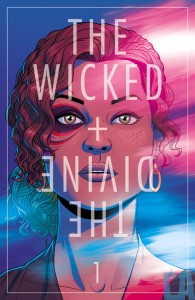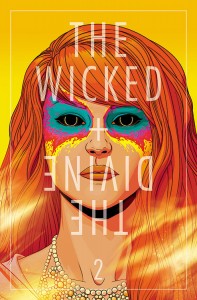The Wicked + The Divine 1 & 2
Reviewed by Tony Keen 07-Aug-14
Kieron Gillen and Jamie McKelvie’s new series conjures up the spirit of Neil Gaiman and Alan Moore at their best.

 Just imagine. It’s London – not our London, but a recognisable London. There’s a girl, dressed as a boy, who reminds you of David Bowie, and Annie Lennox, who’s the reincarnation of a fallen angel. She clicks her fingers, and someone’s head explodes. Welcome to The Wicked + The Divine, a story of “problematic people who will do problematic things”.
Just imagine. It’s London – not our London, but a recognisable London. There’s a girl, dressed as a boy, who reminds you of David Bowie, and Annie Lennox, who’s the reincarnation of a fallen angel. She clicks her fingers, and someone’s head explodes. Welcome to The Wicked + The Divine, a story of “problematic people who will do problematic things”.
I’ve come rather late to the work of Kieron Gillen. He emerged at a time when my comics reading had more-or-less contracted to Love and Rockets and Age of Bronze, so I missed out on stuff like Phonogram, his runs on X-Men and Iron Man, and even Young Avengers. I have read Three, but I have an extremely complicated and not wholly enthusiastic engagement with that work which I have been struggling to articulate for FA – I’ve not yet succeeded.
This comic, however, is rather wonderful.
What’s it about? It’s a fantasy story about gods who are reincarnated as young people (not, Gillen makes explicit, teenagers) every ninety years. It’s a fantasy about London, rooted in the London we all know. The story would not work in New York, or even in Paris. (Hey, if the first trade collection comes out in time, I might set it as reading for next year’s Fantastic London course.) It’s about pop stars and teenagers and exploding heads and everything. And there are no ads, which gives you a bit more story for your $3.50.

I really like the way Luci’s streak of dark hair, normally firmly swept back, breaks loose here. The art is full of lovely details such as this.
What’s it like? It’s like Alan Moore back when he was really, really good – I’m talking early Marvelman or V For Vendetta. The Wicked + The Divine conjures up that same interaction of the fantastic with the reality of the world, so that the attention to detail in the real makes the fantastic more credible. But it’s also like Neil Gaiman’s Sandman in its imaginative use of mythologies in the modern world, and its engagement with the English fantastic. Both Moore and Gaiman are at their best when writing about England, as apparently is Gillen. The Wicked and the Divine is, as I’ve intimated, a very English book.
Gillen demonstrates a really good command of dialogue, especially with Luci(fer), by far the most interesting character in the comic (so far). I found myself smiling a lot as I read it. I can tell that the writing is good, because I can feel it seeping into the way that I’m writing this review.
The comic also looks beautiful, a bit like Glenn Fabry on a good day. A lot of this is down to the clean lines of Jamie McKelvie’s inks – this is also a contributing factor to the realism I mentioned earlier. The pages are full of lovely layouts, with little details that repay rereading. But this isn’t just McKelvie – colorist Matthew Wilson thoroughly deserves his place on the cover credits, creating some beautiful washes that the high quality printing really brings out. Clayton Cowles’ lettering is also well-done – clear, and helping to tell the story. Not named on the cover is designer Hannah Donovan – but her contribution is another important element of the look of this work.
This is an “ongoing” series, planned to last for a couple of years or so (as far as I can tell). It’s going to be a fun ride. You probably can’t get the first two issues as physical artefacts now, but there are e-comics versions, and there will surely be a trade paperback.
There is much more to say about this comic, but right now I can’t articulate it – just as Three somewhat defeats my attempts to say why I don’t fully engage with it, so Wicked + The Divine defeats my fully explaining why I like it so much.
Recommended.
Tags: Clayton Cowles, Image Comics, Jamie McKelvie, Kieron Gillen, Matthew Wilson, The Wicked + The Divine